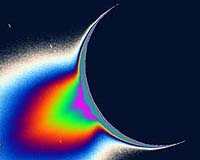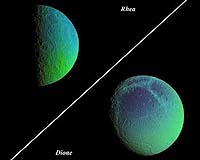
Recent Cassini images of Saturn's moon Enceladus backlit by the sun show the fountain-like sources of the fine spray of material that towers over the south polar region. Image credit: NASA/JPL/Space Science Institute.
Posted on 12/07/2005 1:03:39 PM PST by tricky_k_1972
Cassini Images Reveal Spectacular Evidence Of An Active Moon
 Recent Cassini images of Saturn's moon Enceladus backlit by the sun show the fountain-like sources of the fine spray of material that towers over the south polar region. Image credit: NASA/JPL/Space Science Institute. |
Jets of fine, icy particles streaming from Saturn's moon Enceladus were captured in recent images from NASA's Cassini spacecraft. The images provide unambiguous visual evidence that the moon is geologically active.
"For planetary explorers like us, there is little that can compare to the sighting of activity on another solar system body," said Dr. Carolyn Porco, Cassini imaging team leader at the Space Science Institute in Boulder, Colo.
"This has been a heart-stopper, and surely one of our most thrilling results."
The Cassini images clearly show multiple jets emanating from the moon's south polar region. Based on earlier data, scientists strongly suspected these jets arise from warm fractures in the region. The fractures, informally dubbed "tiger stripes," are viewed essentially broadside in the new images.
The fainter, extended plume stretches at least 186 kilometers (300 miles) above the surface of Enceladus, which is only 186 kilometers wide. Cassini flew through the plume in July, when it passed a few hundred kilometers above the moon.
During that flyby, Cassini's instruments measured the plume's constituent water vapor and icy particles.
Imaging team members analyzed images of Enceladus taken earlier this year at similar viewing angles. It was a rigorous effort to demonstrate that earlier apparitions of the plumes, seen as far back as January, were in fact real and not due to imperfections in the camera.
The recent images were part of a sequence planned to confirm the presence of the plumes and examine them in finer detail. Imaging team member Dr. Andrew Ingersoll from the California Institute of Technology, said, "I think what we're seeing are ice particles in jets of water vapor that emanate from pressurized vents. To form the particles and carry them aloft, the vapor must have a certain density, and that implies surprisingly warm temperatures for a cold body like Enceladus."
Imaging scientists are comparing the new views to earlier Cassini data in hopes of arriving at a more detailed, three-dimensional picture of the plumes and understanding how activity has come about on such a small moon. They are not sure about the precise cause of the moon's unexpected geologic vitality.
 False-color views of Saturn's cratered, icy moons, Rhea and Dione. Image credit: NASA/JPL/Space Science Institute. |
"Only, in the case of Enceladus, the energy source for the geyser-like activity is believed to be due to internal heating by perhaps radioactivity and tides rather than the sunlight which causes cometary jets." The new data also give yet another indication of how Enceladus keeps supplying material to Saturn's gossamer E ring.
Cassini's Photo Album From A Season Of Icy Moons
Pasadena CA (JPL) Dec 07 - Wrapping-up a phenomenally successful year of observing Saturn's icy moons, the Cassini mission is releasing a flood of new views of the moons Enceladus, Dione, Rhea, Hyperion, and Iapetus.
The moons and their intricacies are being highlighted today at a news briefing held today at the American Geophysical Union meeting in San Francisco, Calif.
Several new images of Rhea, a moon measuring 1,528 kilometers (949 miles) across, were taken during Cassini's most recent close flyby on November 26. During the encounter, Cassini dipped to within 500 kilometers (310 miles) of Rhea's surface.
Additional new images include two "zoomable" mosaics of Rhea and Hyperion at high resolution; false-color views revealing compositional variation on the surfaces of Hyperion, Dione and Rhea; two movies reproducing Cassini's exciting encounters with Iapetus and Hyperion; and dazzling new images of the plumes of Enceladus, including a time-lapse movie.
Can anyone possibly argue with 4 possible bodies within our own Solar System that life exists nowhere but Earth and that in all the other Solar Systems throughout just one Galaxy that no other intelligence besides us exists in the Universe?
It has been proven time and again on our own planet that life can exist in the most inhospitable places imaginable.

Looks like a hole in the Ozone layer...dang those SUV's.
So what if we find life in existence on any of these solar bodies, does that crush the world view of uniqueness or does it not in fact enhance the awe of the Creator.
For me it is the later.
Until we get our life-detectors out there and actually detect life, the arguments must continue. It is possible there is life on the moon, on Mars, and on Titan since our robots have landed and might have carried life on them in spite of efforts to make them as sterile as possible.
The thing is, if life exists elsewhere then so should technology-using intelligences -- lots of technology-using intelligences. And we don't see 'em.
So that's a pretty good argument that Earth is unique. It wouldn't surprise me to be wrong on this, but the argument is there.
Err.. Yes most defiantly a bad gas problem.
>The thing is, if life exists elsewhere then so should technology-using intelligences -- lots of technology-using intelligences. And we don't see 'em.
Do bacteria 'see' us?
> The thing is, if life exists elsewhere then so should technology-using intelligences -- lots of technology-using intelligences. And we don't see 'em.
Yes... because *lots* in a universe this big means *very* far away.
What makes you think we'd know about another humanlike species that's, say, a mere 1500 light years away?
Yes.
It has been proven time and again on our own planet that life can exist in the most inhospitable places imaginable.
The question is not whether life can live in an inhospitable place. The question is whether the more specialized conditions required for life to first form and prosper is present or not. And the conditions required for life to first form from inanimate matter is most certainly more specialized thant he conditions to which life, once formed, can adapt.
Just because humans can life in orbit around Earth does not mean that life could first evolve there. Just because bacteria can exist in Antarctic ice does not mean that life could first evolve there.
Asbestos suit donned...
Their might be some other limiting factor such that precludes technological development, but not intelligence. Their maybe some cultural or another hindrance we aren't taking into account.
The Idea that we and we alone or sole intelligence in the entire Universe seems to me to be an expression of utter hubris.
Maybe Einstein is right and there is no way to bend the rules and achieve faster than light travel, although I would not bet on it.
The Jews were God's chosen people, which did not limit the Creation to them or only allow them the spark of intelligence.
And one would arge that the Idea that we share the universe with countless other intelligent beings may simply be an expression of hope and a desire to not be alone in the universe. The only thing anyone can say without expressing wishful thinking or pessimism is that we just don't know if we are alone or not. Everything else is a guess.
Maybe Einstein is right and there is no way to bend the rules and achieve faster than light travel, although I would not bet on it.
The odds are likely that we'll never travel faster than light. See the "light cone" and causality. This isn't like claiming that no car will ever go over 60mph or no plane will ever break the sound barrier.
As a fan of science fiction, I'm not saying this because I like it. It's just what I see when I look at the evidence. Of course I also feel the same way about science fiction energy sources.
If there was one "intelligent" life form per major galaxy in the Universe, the nearest one would be 2 million light years away. That would make it somewhat difficult for them to look us up.
Plus, we don't know how long technically-advanced civilizations can survive. Others could have existed in our own galaxy and gone extinct before we learned how to make wheels.
Disclaimer: Opinions posted on Free Republic are those of the individual posters and do not necessarily represent the opinion of Free Republic or its management. All materials posted herein are protected by copyright law and the exemption for fair use of copyrighted works.